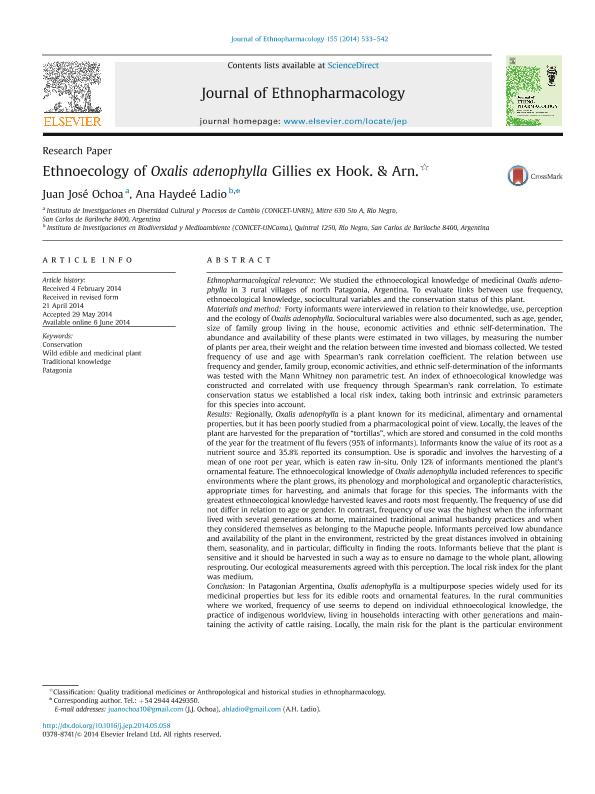Mostrar el registro sencillo del ítem
dc.contributor.author
Ochoa, Juan José

dc.contributor.author
Ladio, Ana Haydee

dc.date.available
2016-01-11T17:12:24Z
dc.date.issued
2014-07
dc.identifier.citation
Ochoa, Juan José; Ladio, Ana Haydee; Ethnoecology of Oxalis adenophylla Gillies ex Hook. & Arn.; Elsevier Ireland; Journal Of Ethnopharmacology; 155; 7-2014; 533-542
dc.identifier.issn
0378-8741
dc.identifier.uri
http://hdl.handle.net/11336/3509
dc.description.abstract
Ethnopharmacological relevance: We studied the ethnoecological knowledge of medicinal Oxalis adenophylla in 3 rural villages of north Patagonia, Argentina. Aim of the study: To evaluate links between use frequency, ethnoecological knowledge, sociocultural variables and the conservation status of this plant. Materials and Method: Forty informants were interviewed in relation to their knowledge, use, perception and the ecology of O. adenophylla. Sociocultural variables were also documented, such as age, gender, size of family group living in the house, economic activities and ethnic self determination. The abundance and availability of these plants were estimated in two villages, by measuring the number of plants per area, their weight and the relation between time invested and biomass collected. We tested frequency of use and age with Spearman´s rank correlation coefficient. The relation between use frequency and gender, family group, economic activities, and ethnic self determination of the informants was tested with the Mann Whitney non parametric test. An index of ethnoecological knowledge was constructed and correlated with use frequency through Spearman´s rank correlation. To estimate conservation status we established a local risk index, taking both intrinsic and extrinsic parameters for this species into account. Results: Regionally, Oxalis adenophylla is a plant known for its medicinal, alimentary and ornamental properties, but it has been poorly studied from a pharmacological point of view. Locally, the leaves of the plant are harvested for the preparation of ?tortillas?, which are stored and consumed in the cold months of the year for the treatment of flu fevers (95 % of informants). Informants know the value of its root as a nutrient source and 35.8% reported its consumption. Use is sporadic and involves the harvesting of a mean of one root per year, which is eaten raw in-situ. Only 12% of informants mentioned the plant?s ornamental feature. The ethnoecological knowledge of O. adenophylla included references to specific environments where the plant grows, its phenology and morphological and organoleptic characteristics, appropriate times for harvesting, and animals that forage for this species. The informants with the greatest ethnoecological knowledge harvested leaves and roots most frequently. The frequency of use did not differ in relation to age or gender. In contrast, frequency of use was highest when the informant lived with several generations at home, maintained traditional animal husbandry practices and when they considered themselves as belonging to the Mapuche people. Informants perceived low abundance and availability of the plant in the environment, restricted by the great distances involved in obtaining them, seasonality, and in particular, difficulty in finding the roots. Informants believe that the plant is sensitive and that it should be harvested in such a way as to ensure no damage to the whole plant, allowing resprouting. Our ecological measurements agreed with this perception. The local risk index for the plant was medium. Conclusion: In Patagonian Argentina, Oxalis adenophylla is a multipurpose species widely used for its medicinal properties but less for its edible roots and ornamental features. In the rural communities where we worked, frequency of use seems to depend on individual ethnoecological knowledge, the practice of indigenous cosmology, living in households interacting with other generations and maintaining the activity of cattle raising. Locally, the main risk for the plant is the particular environment where it grows, characterized by slopes vulnerable to erosion. The human practice of local use could promote the conservation of this species through the understanding of its sensitivity to harvesting, and its insipient cultivation. This research shows the importance of obtaining a general overview of useful wild species used by local people.
dc.format
application/pdf
dc.language.iso
eng
dc.publisher
Elsevier Ireland

dc.rights
info:eu-repo/semantics/openAccess
dc.rights.uri
https://creativecommons.org/licenses/by-nc-nd/2.5/ar/
dc.subject
Conservation
dc.subject
Wild Edible Plants
dc.subject
Traditional Knowledge
dc.subject
Patagonia
dc.subject.classification
Otros Tópicos Biológicos

dc.subject.classification
Ciencias Biológicas

dc.subject.classification
CIENCIAS NATURALES Y EXACTAS

dc.title
Ethnoecology of Oxalis adenophylla Gillies ex Hook. & Arn.
dc.type
info:eu-repo/semantics/article
dc.type
info:ar-repo/semantics/artículo
dc.type
info:eu-repo/semantics/publishedVersion
dc.date.updated
2016-03-30 10:35:44.97925-03
dc.journal.volume
155
dc.journal.pagination
533-542
dc.journal.pais
Irlanda

dc.description.fil
Fil: Ochoa, Juan José. Consejo Nacional de Investigaciones Científicas y Técnicas. Centro Científico Tecnológico Patagonia Norte. Instituto de Investigaciones en Diversidad Cultural y Procesos de Cambio; Argentina
dc.description.fil
Fil: Ladio, Ana Haydee. Consejo Nacional de Investigaciones Científicas y Técnicas. Centro Científico Tecnológico Patagonia Norte. Instituto de Investigación En Biodiversidad y Medioambiente; Argentina
dc.journal.title
Journal Of Ethnopharmacology

dc.relation.alternativeid
info:eu-repo/semantics/altIdentifier/doi/http:/dx.doi.org/10.1016/j.jep.2014.05.058
dc.relation.alternativeid
info:eu-repo/semantics/altIdentifier/url/http://sciencedirect.com/science/article/pii/S0378874114004279
Archivos asociados
